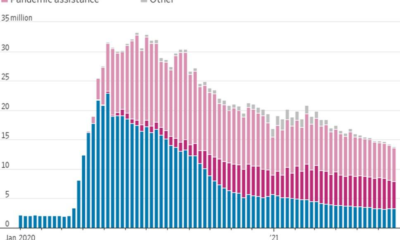Money
Ukraine Starts Using Facial Recognition To Identify Dead Russians And Tell Their Relatives – Forbes

Ukraine’s deputy prime minister says the tech will help provide transparency about how many Russian soldiers are dying in the war. Critics say the use of facial recognition in war zones is a disaster in the making.
Ukraine is using Clearview AI facial recognition to identify dead Russian soldiers as part of a campaign to combat Kremlin disinformation on the number of dead from the war.
Find a photo of a dead Russian soldier on social media. Upload it to facial recognition software. Get an identity match from a database of billions of social media images. Identify the deceased’s family and friends. Show them what happened to the victim of Putin’s war and Ukraine’s defense.
This is one of Ukraine’s strategies in trying to inform Russians, who have limited access to non-state-controlled media and information, about the death being wrought by their president’s invasion. On Wednesday, deputy prime minister and head of the Digital Transformation Ministry in Ukraine, Mykhailo Fedorov, confirmed on his Telegram profile that surveillance technology was being used in this way, a matter of weeks after Clearview AI, the New York-based facial recognition provider, started offering its services to Ukraine for those same purposes. Fedorov didn’t say what brand of artificial intelligence was being used in this way, but his department later confirmed to Forbes that it was Clearview AI, which is providing its software for free. They’ll have a good chance of getting some matches: In an interview with Reuters earlier this month, Clearview CEO Hoan Ton-That said the company had a store of 10 billion users’ faces scraped from social media, including 2 billion from Russian Facebook alternative Vkontakte. Fedorov wrote in a Telegram post that the ultimate aim was to “dispel the myth of a ‘special operation’ in which there are ‘no conscripts’ and ‘no one dies.’”
Just a month ago, Clearview AI and facial recognition were the subject of strong criticism. U.S. lawmakers decried its use by the federal government, saying the technology disproportionately targeted Black, Brown and Asian ethnicities and falsely matched them more often when compared to white individuals. They also made clear the existential threat to privacy the software posed. Civil rights organizations like the American Civil Liberties Union don’t believe the technology should be used in any setting, calling for outright bans.
The use case in Ukraine, of course, is vastly different from the ones typically seen in the U.S., which try to identify criminal suspects. Identifying dead Russian soldiers might be more acceptable, if the ultimate aim is to let people know their loved ones have died as a result of their leader’s warmongering. Not to mention that the dead don’t have a right to privacy—not according to U.S. law, anyway. It’s one reason why police are allowed to unlock iPhones or other smart devices of the deceased by holding it up to their face (even if they may not have much success, due to liveness detection). But should privacy advocates worry about the use of facial recognition in wartime, when it might legitimize the tech for use in other scenarios where the living’s privacy is under threat?
For Ukraine, it believes there is a need to identify dead Russian soldiers, as there’s much contention over the numbers of deceased military personnel. Last week, a Russian newspaper published and subsequently deleted a report claiming nearly 10,000 Russian soldiers had died since the invasion began, far more than had been previously reported. Later the tabloid claimed it had been hacked and the figures were not correct. Ukraine believes Russia is lying to its citizens about the number of the dead.
But Albert Fox Cahn, founder of the Surveillance Technology Oversight Project, said the introduction of facial recognition into the war could be disastrous, even if Ukraine is using it to tell the truth to Russian citizens. “This is a human rights catastrophe in the making. When facial recognition makes mistakes in peacetime, people are wrongly arrested. When facial recognition makes mistakes in a war zone, innocent people get shot,” he told Forbes.
“I’m terrified to think how many refugees will be wrongly stopped and shot at checkpoints because of facial recognition error. We should be supporting the Ukrainian people with the air defenses and military equipment they ask for, not by turning this heartbreaking war into a place for product promotion.”
Facial recognition has also been shown to be fallible, falsely matching images of people’s faces to the wrong identity. In the U.S., this has happened at least three times to Black individuals, who were wrongly arrested because their face erroneously matched with footage from surveillance cameras.
As Cahn noted, “When facial recognition inevitably misidentifies the dead, it will mean heartbreak for the living.”
When asked about those concerns or the use of its technology, Hoan Ton-That, CEO of Clearview AI, said, “War zones can be dangerous when there is no way to tell enemy combatants apart from civilians. Facial recognition technology can help reduce uncertainty and increase safety in these situations.”
He said that U.S.-government funded tests had shown that Clearview “can pick the correct face out of a lineup of over 12 million photos at an accuracy rate of 99.85%.” That accuracy “will prevent misidentifications from happening in the field.”
“The Ukrainian officials who have received access to Clearview AI have expressed their enthusiasm, and we await to hear more from them. We are ensuring each person with access to the tool is trained on how to use it safely and responsibly,” he added.
Whatever the morals at play, the use of facial recognition in this war is remarkable in its use as a tool in the propaganda war. Or as Ukraine would put it, the war for truth. Even Fedorov didn’t think he’d be using the technology for this before the invasion, writing in his Telegram post, “We have all changed. We started doing things we couldn’t even imagine a month ago.”
Money
Where Tech Talent Goes To Thrive

here is a worldwide shortage of digital skills. In a world increasingly reliant on technology, demand for technological skillsets is rising by as much as 50%. Meanwhile, nearly three-quarters of today’s workers don’t feel equipped to learn the digital skills needed by businesses.
The most acute shortage is in advanced skills like programming, especially for new technologies like AI and blockchain.
This demand gives skilled tech workers, entrepreneurs, and leaders the pick of where to base themselves. As cities and nations compete to attract tech talent, what makes these prized individuals choose one place over another?.
Initial Attraction
In a survey of ‘tech migrants’, Boston Consulting Group identified a mixture of short-, medium-, and long-term levers businesses and cities could use to attract talent.
The initial attraction is often brute economics: higher pay and lower taxes. That’s certainly what brings people to Dubai, says Vladimir Vrzhovski, Tech and Digital Lead at Mercer: “Dubai pays about 30% higher than most of the mature tech hubs around Europe and Asia.” It also has a lower cost of living, especially when its 0% income tax is taken into account.
Businesses operating in the city’s free zones – like the tech-focused Dubai Internet City (DIC) and Dubai International Finance Centre (DIFC) Innovation Hub – also benefit from 0% corporation tax. BCG credits the incentive with bringing big names like Amazon, Google, and Oracle to the emirate.
It is an echo of London’s rise to tech prominence, offering tax relief on tech investments via its Seed Enterprise Investment Scheme (SEIS) to funnel the city’s vast pools of finance towards digital businesses.
The presence of blue-chip names affords another major draw for tech talent: opportunities.
Money
Adding exercise into treatment may reduce substance use, study shows

One key to fighting addiction may be exercise, according to a new study.
Researchers undertook a review of the existing literature around physical activity and its relationship to substance use, and they found that regular exercise was associated with lowered use in about 75% of the studies investigating that question, according to the analysis.
The review, published Wednesday in the journal PLOS ONE, looked at 43 studies with more than 3,000 total participants. In addition to a reduction or cessation in substance use, the studies also found improved markers of physical health and decreased depressive symptoms, the study said.
“People think that during treatment people should only do psychotherapeutic treatments … but that’s not what we’ve seen in our study,” said lead study author Florence Piché, a doctoral student and researcher at Université de Montréal in Canada. “It’s very beneficial to do physical activity in addition to the treatments.”
There are limitations to the findings. The review found that most of the studies the researchers examined had a high risk of bias, meaning more research is needed to confirm their findings, said Dr. Aaron Kandola, research fellow at Medical Research Council Unit for Lifelong Health and Ageing at University College London.
The studies were also not directly comparable enough to build a comprehensive and generalizable understanding of the relationship, Kandola said in an email. Kandola was not part of the research.
However, the findings were still significant and useful, he added.
“Substance use disorders are a major public health problem lacking low-cost, evidence-based solutions,” he said, adding that substance use disorders are worsening in many high-income countries — including the United States.
Finding more accessible solutions to this disorder is especially important because it often occurs with other mental health problems such as depression and anxiety, which disproportionately affect people with fewer socioeconomic resources and areas with higher deprivation, he said.
Physical activity may be a useful and accessible part of a treatment plan for substance use disorder, said Dr. Mark Smith, professor of psychology at Davidson College in North Carolina. Smith was not part of the research.
“I think there’s now a sufficient amount of data to indicate that various forms of physical activity and exercise are generally effective at reducing substance use in individuals seeking treatment,” he said.
What exercise does
Most people can benefit from engaging in physical activity, Kandola said.
One benefit the studies found is improvements in physical health such as cardiovascular endurance or muscle strength, Smith said. And although that may not be the primary goal of the research, he said this finding is important because it shows the physical activity is doing its job to promote physical health.
Money
Blood sugar drug tirzepatide also leads to substantial weight loss in diabetes patients, Eli Lilly says

There’s more evidence that the injectable drug tirzepatide helps people with diabetes lose weight as well as control their blood sugar, according to the drug’s manufacturer, Eli Lilly and Company.
In a new study, more than 900 adults with obesity and diabetes took the drug for a year and five months, and those on the highest dose lost an average of 34 pounds, or nearly 16% of their starting weight. It also helped people reduce their blood sugar, the company said in a news release. The data has not yet been peer-reviewed or published in a medical journal.
“We have not hit 15% in any other phase three trial for weight management in this type two diabetes population,” said Dr. Nadia Ahmad, an associate vice president at Eli Lilly and medical director of obesity clinical development for the company.
Ahmad said the company was pleased with these results, given how hard it is for people with type 2 diabetes to lose weight.
Tirzepatide is currently sold as Mounjaro and approved to help people with type 2 diabetes control their blood sugar.
Lilly says it will use the new study, along with results from an earlier study of weight loss in people without diabetes, to ask the US Food and Drug Administration to fast-track approval for tirzepatide purely for weight loss, which would make it a direct competitor to the blockbuster obesity drug Wegovy.
Plenty of people aren’t waiting for the FDA’s nod.
“I am aware of and I’ve heard, you know, it being sort of used off label for weight loss and individuals who do not have diabetes,” said Dr. Kimberly Gudzune, medical director of the American Board of Obesity Medicine. Gudzune was not involved in the tirzepatide study.
Gudzune points out that once a drug is FDA approved it can be prescribed for any reason a doctor sees as medically necessary.
Tirzepatide, along with several similar types of drugs taken for diabetes, went into shortage last year as success stories posted on social media fueled runaway demand for their weight loss benefits. The shortages made the medications difficult for patients with diabetes to get.
Tirzepatide works by mimicking the action of two different gut hormones. When blood sugar rises after eating, the drug stimulates the body to produce more insulin, which lowers blood sugar. It also slows down the movement of food from the stomach, making people feel fuller for longer. In clinical trials, people who took tirzepatide experienced more nausea, vomiting and diarrhea compared with those who took a placebo injection.
Semaglutide, manufactured by Novo Nordisk, has also been approved as a weight loss medication for overweight adults with at least one associated health problem since 2021. When prescribed for weight loss, it is sold under the brand name Wegovy. When prescribed for diabetes, the injection is sold under the brand name Ozempic.
High demand, coupled with manufacturing problems, threw Wegovy into shortage for much of the last year. That shortage then rippled into shortages for diabetes patients as doctors began prescribing other diabetes medications off-label for weight loss.
There has already been a lot of buzz about tirzepatide’s potential as an obesity medication. In a clinical trial published in the New England Journal of Medicine last year, people who were overweight or obese, but did not have diabetes, lost an average of 52 pounds on the highest dose of the drug, or more than 20% of their starting weight.
“In the last year has been really exciting just to have more tools in the toolbox, so to speak. And tools that, you know, we’re seeing really achieving outcomes that patients for the longest time have been hoping to achieve,” Gudzune said.
If those results hold up in the real world, that would make it the most potent of the injectable weight loss medications.
Indeed, this week Lilly aims to begin a study that will test Mounjaro against Wegovy head-to-head in 700 participants at 61 sites in the United States and Canada, according to clinicaltrials.gov. The study will conclude in February 2025.
-

 Business3 years ago
Business3 years agoHyundai Leads Industry in U.S. News & World Report 2023 Best Cars for the Money Awards
-

 Innovation3 years ago
Innovation3 years agoJay-S ventures into the urban genre with “Bailar en la Playa” his latest production
-

 Business3 years ago
Business3 years agoThree Questions Small Business Owners Should Ask In Creating A Workplace Culture – Forbes
-

 Business3 years ago
Business3 years agoA Fintech Makes It Easy For Small Businesses To Offer 401(k) Retirement Benefits – Forbes
-

 Business3 years ago
Business3 years agoBritain’s Small Businesses See Better Times Ahead But Is Their Optimism Justified? – Forbes
-

 Money3 years ago
Money3 years agoCharlie Crist leads Democratic gubernatorial field again in money chase – Florida Politics
-

 Money3 years ago
Money3 years agoTesting New Tools for Horizon Worlds Creators To Earn Money
-

 Business3 years ago
Business3 years agoSmall Business Labor Shortage – Forbes
